Ragi roti, made from finger millet flour, is not only a gluten-free roti but is also packed with tons of essential nutrients. Let us make these simple, easy, soft, and flavorful ragi rotis. Whether you have specific dietary requirements or simply want to explore new culinary options, this flatbread also called Nachni roti, is a fantastic choice.
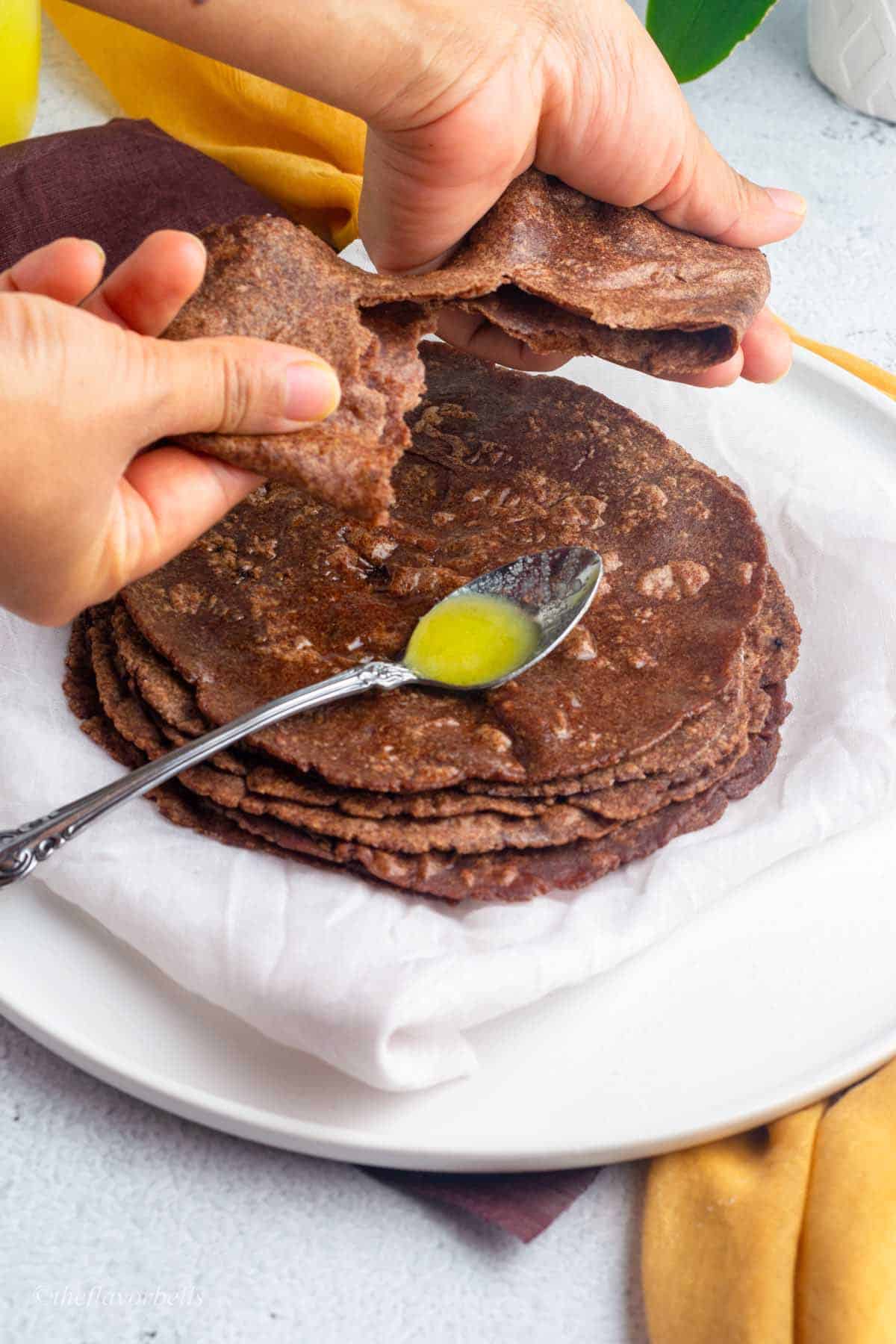
It is known by different names throughout India. Nachni Roti, ragi chapati, ragi ki roti, madua ki roti, Marua ki roti, nachni roti, etc. to name a few.
These flatbread recipes might interest you: Turkish bread recipe, sourdough naan, parotha, and pita bread.
🫓 What is Ragi Flour?
Ragi flour, also known as finger millet flour, is a type of flour made from ragi, a grain that is primarily grown in Africa and Asia. Ragi is a cereal crop widely cultivated in countries like India, Ethiopia, and Uganda. The scientific name of ragi is Eleusine coracana.
It is prepared by milling or grinding the ragi grains into a fine powder. It has a light brown or beige color and a slightly coarse texture. Ragi flour is gluten-free flour, which makes it a suitable alternative for individuals with gluten sensitivities or those following a gluten-free diet.
Ragi flour is highly nutritious and rich in several essential nutrients. It is a good source of dietary fiber, protein, calcium, iron, and other minerals. It is also known for its high content of antioxidants and phytochemicals. Due to its nutritional profile, ragi flour is considered a healthy choice and is commonly used in various cuisines.
In Indian cuisine, ragi flour is often used to make traditional dishes like ragi roti (flatbread), ragi paratha, ragi dosa (crepe), and ragi porridge in the South Indian states. It can also be incorporated into baked goods like bread, cookies, and muffins to enhance their nutritional value.
Ragi flour has gained popularity in recent years due to its health benefits and versatility in cooking. People eat ragi roti for weight loss, to regulate blood sugar levels, to promote digestion, and provide sustained energy.
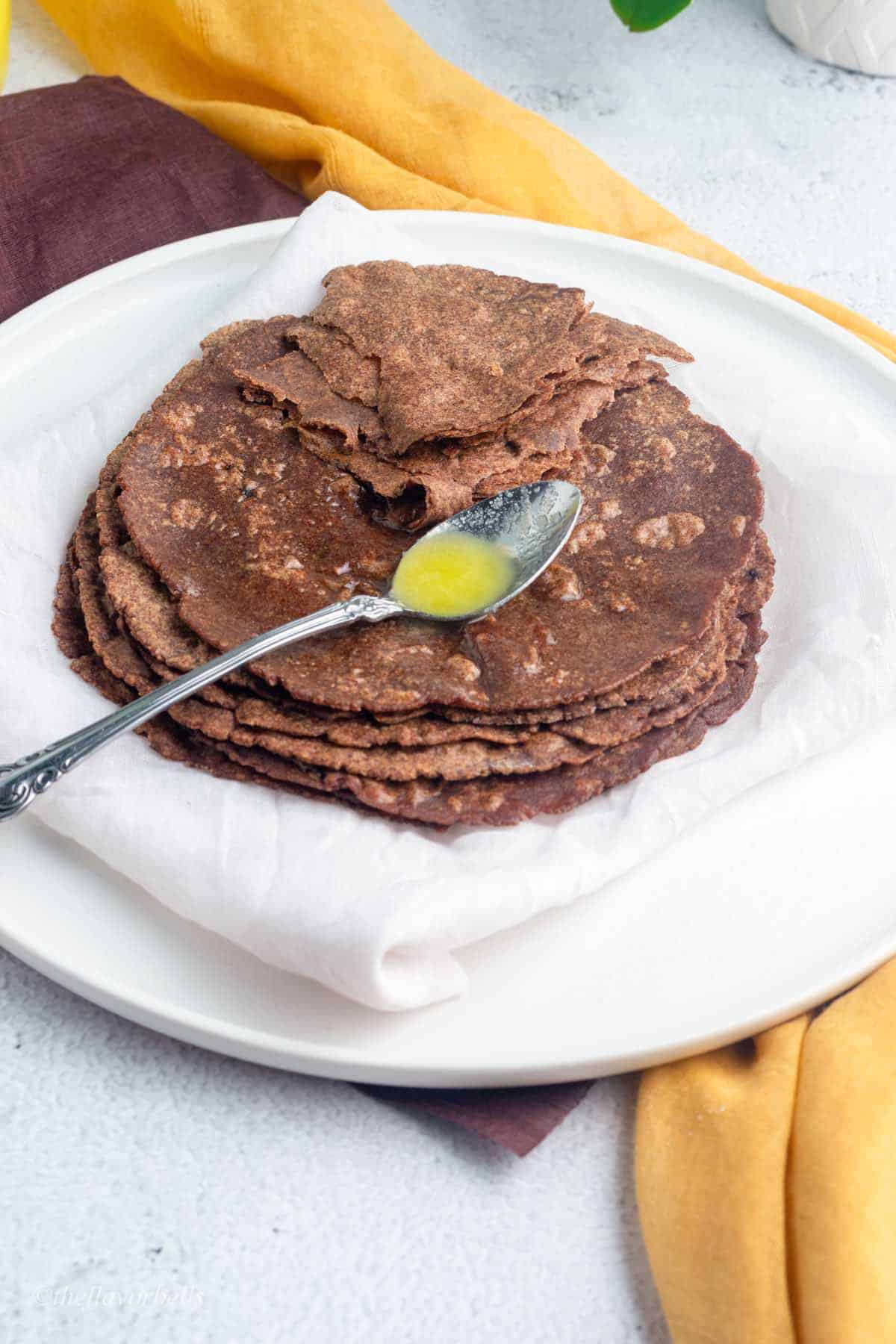
Jump to:
🍞 Why make these Gluten-free Ragi Roti?
Eating ragi roti made freshly at home offers several health benefits. Let us also look at the ragi roti benefits.
- Earthy and nutty flavor. These soft ragi roti have a very nice nutty and earthy flavor.
- Super easy recipe: Making this gluten-free Nachni roti is super easy and will be ready from start to finish in no time.
- Nutritional Value: These healthy gluten free rotis are packed with essential nutrients. These are rich in dietary fiber, which aids in digestion, promotes satiety, and helps maintain a healthy weight. It is also a good source of protein, calcium, iron, and other minerals, making it a nutritious addition to your diet.
- Gluten-Free recipe: Ragi flour roti is an excellent choice for individuals with gluten sensitivities or those following a gluten-free diet. Since ragi is naturally gluten-free, it can be a healthier substitute for wheat-based rotis.
- Blood Sugar Regulation: Ragi has a low glycemic index, meaning it causes a slower and more gradual rise in blood sugar levels compared to refined wheat flour or whole wheat flour. Consuming ragi roti can help regulate blood sugar levels, making it beneficial for individuals with diabetes or those at risk of developing the condition.
- Bone Health: Ragi is an excellent source of calcium, which is essential for maintaining strong bones and teeth.
- It's worth noting that while gluten-free rotis offers numerous health benefits, it's important to maintain a balanced diet that includes a variety of foods to ensure you obtain all the necessary nutrients.
🍶 Ingredients required to make ragi roti
- Ragi flour: Ragi flour, commonly referred to as finger millet flour, is derived from the ragi grain, which is predominantly cultivated in Africa and Asia. This flour is produced by finely grinding or milling the ragi grains, resulting in a fine powder with a gentle brown or beige hue and a slightly grainy texture. You can easily find it in India, but if you live abroad, the only place to source it is an Indian grocery store or online store like Amazon.
- Ghee. You can replace ghee with any other form of fat of your choice.
- Salt. It is an optional ingredient. Many people do not add any salt to ragi roti. But I like to have some flavor on them.

🔪 How to make ragi roti?
Step 1 Hydrating the ragi flour
Ragi flour has a slightly coarse texture it needs to be soaked in boiling water to obtain maximum hydration.
So, start by combining salt and ragi flour in a bowl. Then boil a cup of warm water in a saucepan. As the water starts to boil, turn off the flame and add ragi flour to the boiling water. Use the back of a wooden ladle to mix the flour in boiling water. Just make sure to hydrate most of the flour. There is no need to try kneading at this stage. Simply combine gluten-free ragi flour in boiling water and cover the saucepan.

Leave it covered for 15-20 minutes or until the dough becomes comfortable to touch. The dough should not become cold. We need it still to be warm.
Step 2 Kneading the dough
Now empty the contents of the saucepan onto a work surface and start kneading the dough. You can add a teaspoon of water if it feels stretchy. When the ragi dough comes together as a single ball, add a teaspoon of melted ghee and knead for additional 3-4 minutes.
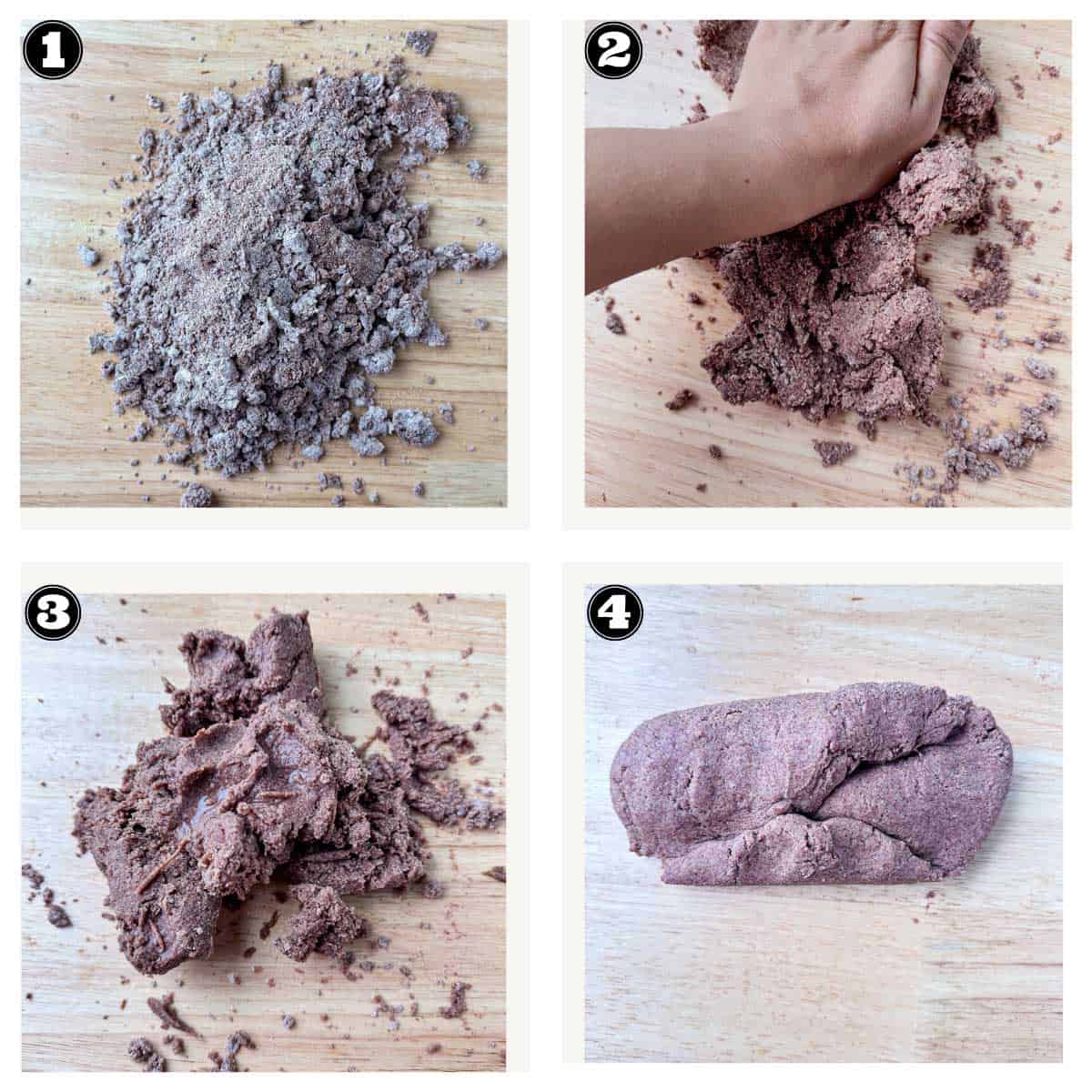
Step 3 Dividing the dough and roll gluten free ragi roti
Once the dough is ready, cover it with a damp cloth and let it rest for 5 minutes. Now divide it into small portions and roll each portion into a ball.
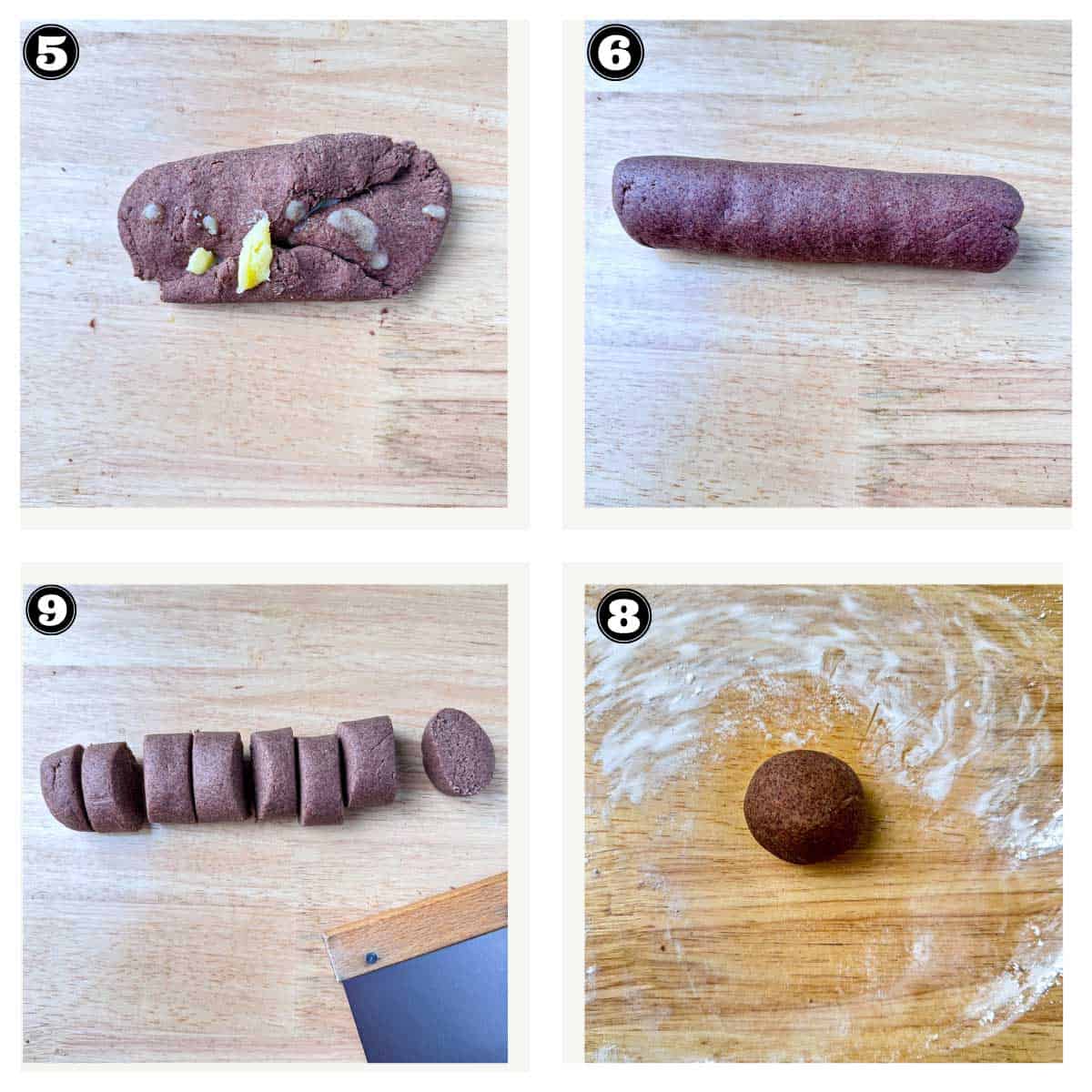
Take a dough ball and flatten it slightly. Dust it with some corn starch to prevent sticking. You can use any flour of your choice. Ragi flour is not usually recommended due to its coarse texture.
Place the flattened dough ball on a clean, flat surface or a rolling board. Using a rolling pin, roll it gently into a circular shape, like a chapati or roti. If the dough sticks to the rolling pin or surface, sprinkle some more flour.
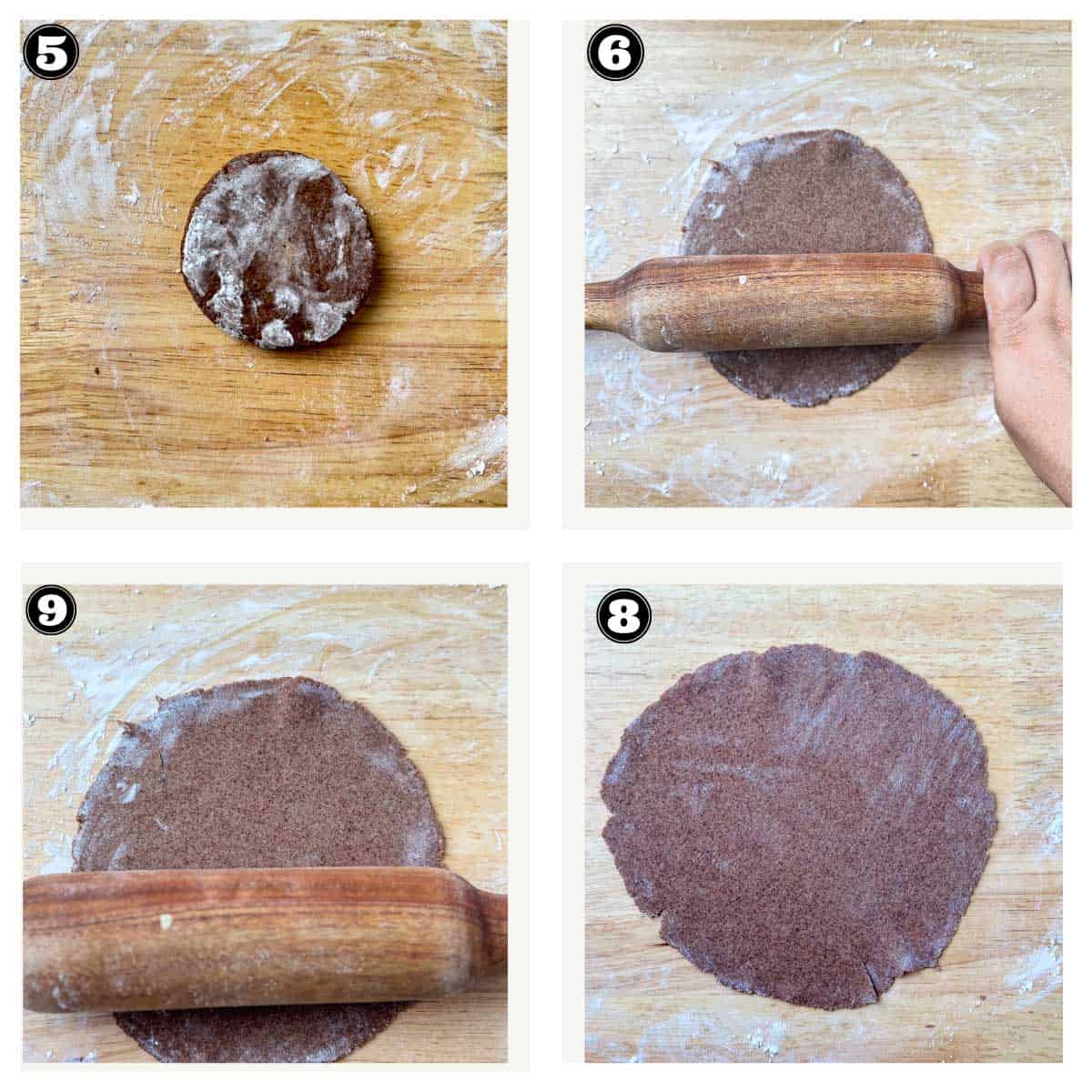
Step 4 Cooking the Ragi roti
Heat a tawa or a flat griddle over medium heat. Place the rolled ragi roti on the hot tawa. After a minute or so, when you start to see bubbles forming on the surface, flip the roti to the other side. Cook the other side for another minute until you see brown spots and the roti is cooked evenly.
Remove the ragi roti from the tawa and apply some ghee or oil on top. This step is optional but adds flavor and helps keep the rotis soft.
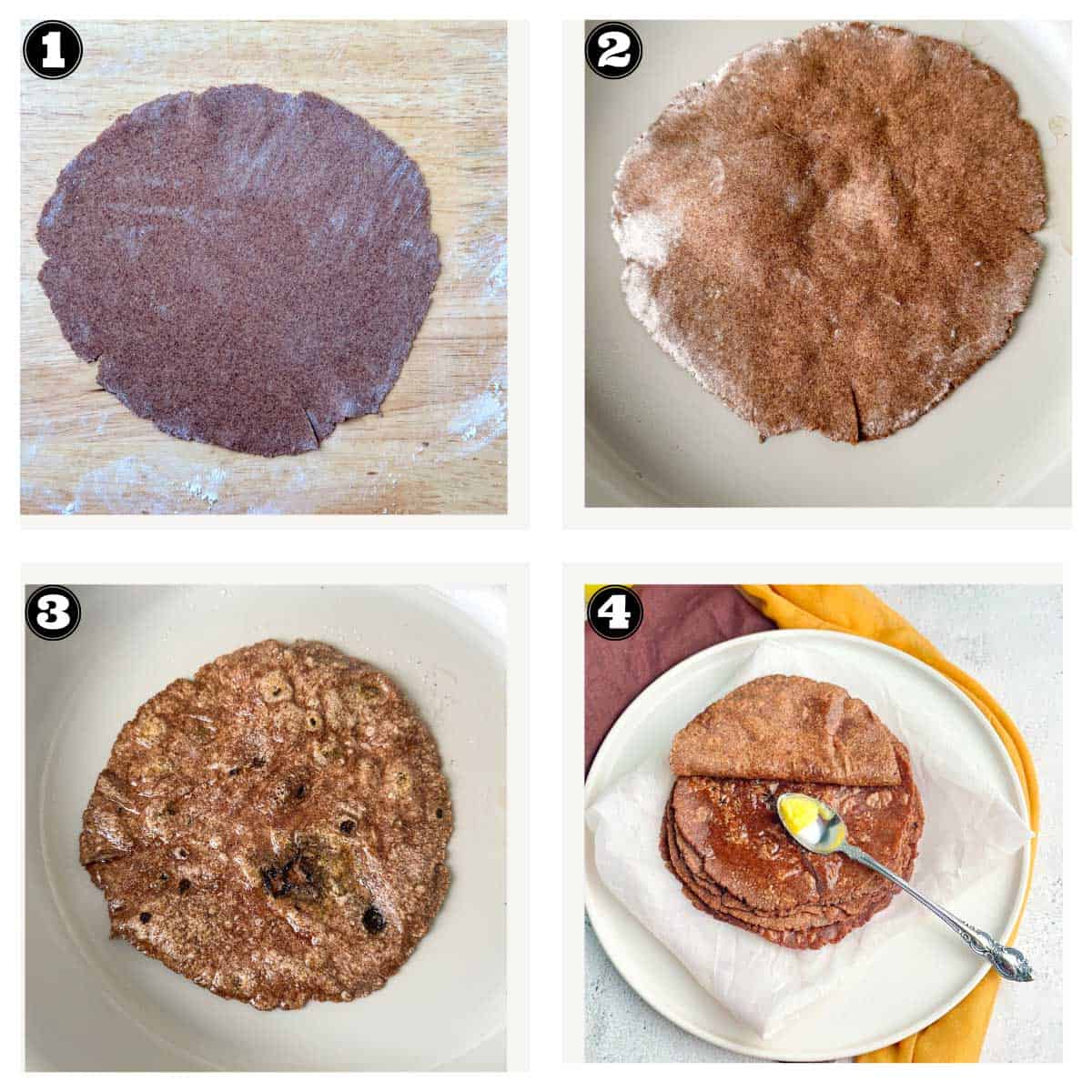
Repeat the process with the remaining dough balls until all the ragi rotis are cooked. I made 8 small nachni or ragi roti from this recipe.
Serve ragi roti hot with any curry, chutney, or yogurt as per your preference.
Enjoy your soft, nutritious, and delicious ragi rotis!
🫙How to store gluten free ragi roti?
To store the finger millet roti and maintain its freshness, follow these guidelines:
- Store it warm. Do not let the ragi roti cool before storing. Smear a freshly cooked ragi with ghee and immediately place it in a hot case or any closed container. Unlike leavened bread, flatbreads needs to be stored warm to retain their softness.
- Stack and Wrap: Stack the ragi rotti on top of each other and wrap in a kitchen towel or linen.
- Wrap Properly: If storing, wrap the stack of ragi roti tightly in aluminum foil or plastic wrap. This will help retain moisture and prevent the rotis from drying out.
- Refrigerate: Place the wrapped ragi roti stack in an airtight container or sealable plastic bag and store it in the refrigerator. This will help extend its shelf life. If stored at room temperature consume within 2 days.
- Consume within a Few Days: Ragi roti can be stored in the refrigerator for up to 3-4 days. However, it is best to consume it as soon as possible for optimal taste and freshness.
- Reheating: When you're ready to eat the stored ragi roti, reheat it on a tawa (flat griddle) or in a skillet over low to medium heat. This will help restore its softness and make it more enjoyable to eat.
Remember that ragi roti is best enjoyed fresh, so it's recommended to prepare and consume it warm for the best taste and texture. Storing it for longer periods may cause it to become dry or lose its quality.

❓Frequently Asked Questions
Nachni roti, also known as Ragi roti, is a type of Indian flatbread made from nachni flour, which is derived from ragi or finger millet. Ragi is a nutritious grain widely grown in India and other parts of Asia and Africa.
To make nachni roti, the ragi flour is combined with water, salt, and sometimes other ingredients like finely chopped onions, green chilies, or spices. The mixture is kneaded into a dough and then rolled into flat, round rotis. These rotis are cooked on a tawa (flat griddle) or skillet until they are golden brown and cooked through.
Nachni roti is highly nutritious and offers several health benefits. It is gluten-free and rich in dietary fiber, protein, calcium, iron, and other essential nutrients. It has a distinctive earthy flavor and a slightly coarse texture.
Nachni roti is commonly consumed in regions of India, especially in the states of Karnataka and Maharashtra. It is often enjoyed with accompaniments like chutney, pickle, curries, or yogurt. Due to its high nutritional content and gluten-free nature, nachni roti is a popular choice for individuals with dietary restrictions or those seeking healthier alternatives to wheat-based bread.
Yes, "nachni" is another name for ragi. Both terms refer to the same grain, which is known scientifically as Finger Millet or Eleusine coracana. Ragi is commonly called "nachni" in some regions of India, particularly in Maharashtra and parts of North India. It's worth noting that regional names for crops can vary, and "nachni" is one of the local names used to refer to ragi in specific areas.
The key to make ragi roti or ragi flour chapati soft and with long lasting softness, is to hydrate it nicely in boiling hot water before kneading. Also allowing the ragi flour to hydrate while it cools ensure long lasting rotis. Also adding ghee to the dough makes soft ragi roti.
An additional thing that you can do is to smear the freshly cooked ragi roti with ghee and place in closed container like a hot case. This prolongs the softness and the rotis do not get hard on cooling.
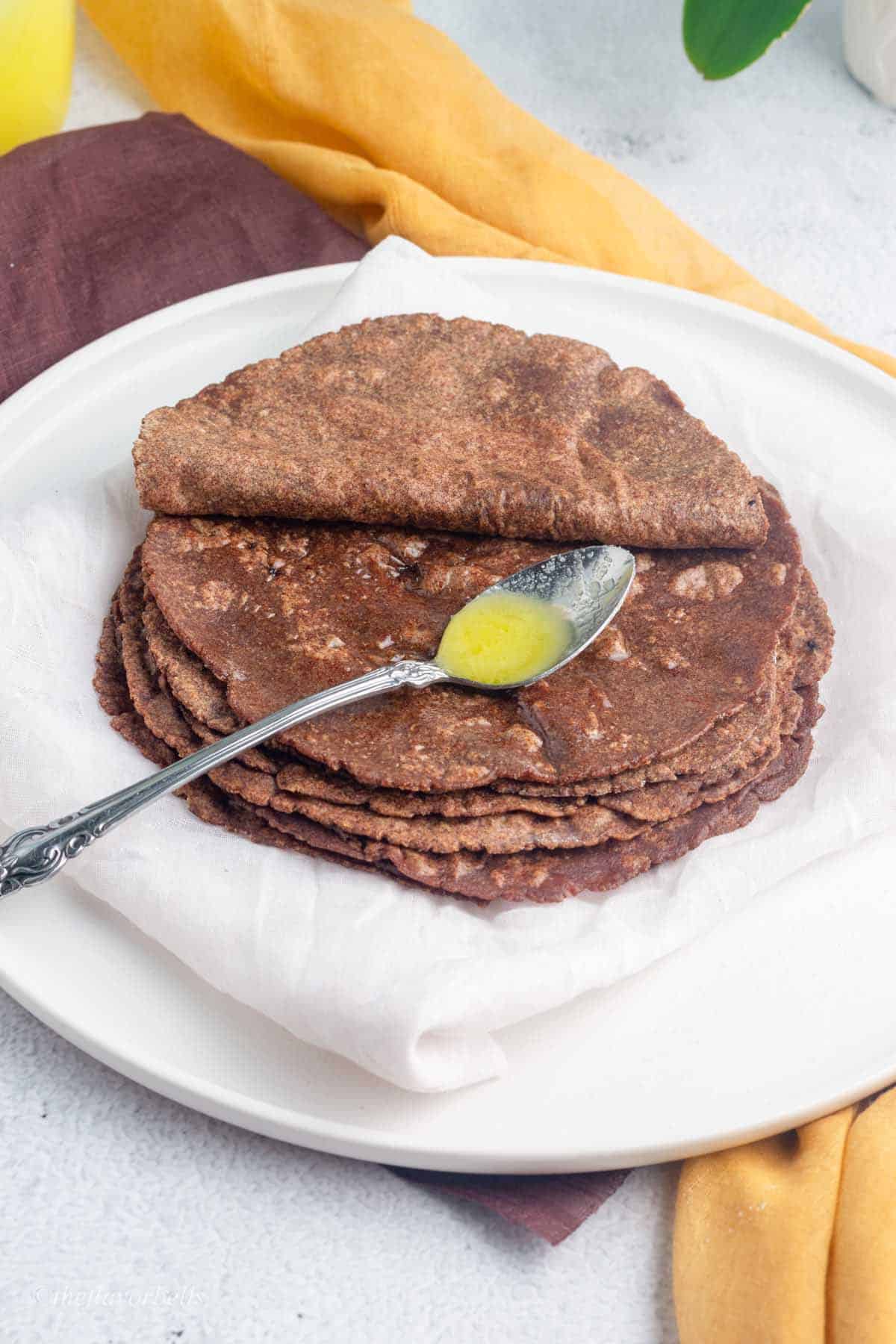
🥖More bread recipes
- Semolina Bread with Sesame Seeds
- Chocolate buns
- Turkish Bread
- Dairy free bread: The best whole wheat vegan milk bread
- How to bake perfect bread in Instant pot
- Tiger rolls: A foolproof Dutch crunch bread recipe
- Matcha Bread (Eggless Matcha Swirl Bread)
- Coffee Buns ( Eggless Mexican Bun Recipe)
🥬More vegan bread recipes
A few vegan bread recipes
- The best garlic sourdough bread recipe
- Sourdough chocolate bread recipe: Easy and delicious !
- How to make sourdough hot dog buns from scratch?
- Ciabatta bread
- Vegan challah buns
- Dairy Free bread
- Vegan Hamburger Buns
- Vegan Bagels recipe
- Vegan English Muffins

Discover the magic of the gluten-free soft ragi roti with a deep nutty flavor. Do give this ragi roti recipe a try and do not forget to share your experience in the comment section below.
Till then
Bake it Delicious!
📝 Recipe Card
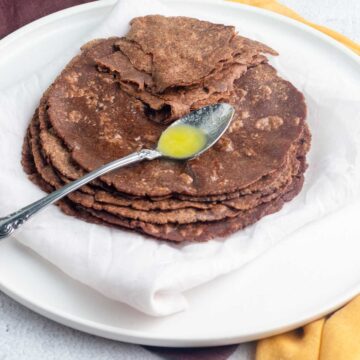
Ragi Roti: Gluten Free Roti
Ingredients
- 1 cup ragi flour
- 1 cup water
- ¼ teaspoon salt
- 1 teaspoon ghee
Instructions
Step 1 Hydrating the ragi flour
- Start by combining salt and ragi flour in a bowl.
- Then boil a cup of warm water in a saucepan. As the water starts to boil, turn off the flame and add ragi flour to the boiling water. Use the back of a wooden ladle to mix the flour in boiling water. Just make sure to hydrate most of the flour.
- Leave it covered for 15-20 minutes or until the dough becomes comfortable to touch.
Step 2 Kneading the dough
- Now empty the contents of the saucepan onto a work surface and start kneading the dough. You can add a teaspoon of water if it feels stretchy.
- When the ragi dough comes together as a single ball, add a teaspoon of melted ghee and knead for additional 3-4 minutes.
Step 3 Dividing the dough and roll gluten free ragi roti
- Once the dough is ready, cover it with a damp cloth and let it rest for 5 minutes.
- Now divide it into small portions and roll each portion into a ball.
- Take a dough ball and flatten it slightly. Dust it with some corn starch to prevent sticking. You can use any flour of your choice. Ragi flour is usually not recommended due to its coarse texture.
- Place the flattened dough ball on a clean, flat surface or a rolling board. Using a rolling pin, roll it gently into a circular shape, like a chapati or roti.
- If the dough sticks to the rolling pin or surface, sprinkle some more flour.
Step 4 Cooking the Ragi roti
- Heat a tawa or a flat griddle over medium heat. Place the rolled ragi roti on the hot tawa.
- After a minute or so, when you start to see bubbles forming on the surface, flip the roti to the other side.
- Cook the other side for another minute until you see brown spots and the roti is cooked evenly.
- Remove the ragi roti from the tawa and apply some ghee or oil on top. This step is optional but adds flavor and helps keep the rotis soft.
- Repeat the process with the remaining dough balls until all the ragi rotis are cooked. I made 8 small gluten free rotis from this recipe.
- Serve ragi roti hot with any curry, chutney, or yogurt as per your preference.
Notes
- Do not attempt to knead the dough when added in boiling water. The purpose is to hydrate the flour. Since it is very high in fiber, it needs some time to soak. Otherwise, you will have ragi roti that will become hard and dry quickly after cooking.
- Do not let the dough cool. It is best to start kneading warm dough mass for making soft ragi chapati.
- If you want crack-free roti with smooth edges, knead every dough ball again in your hands before rolling them.
- Adding ghee while kneading makes soft gluten free roti. You can substitute ghee with melted or softened butter.
- Wrap the cooked rotis and put them in a container with a tight lid if you are not consuming them immediately.
📋Nutrition Facts
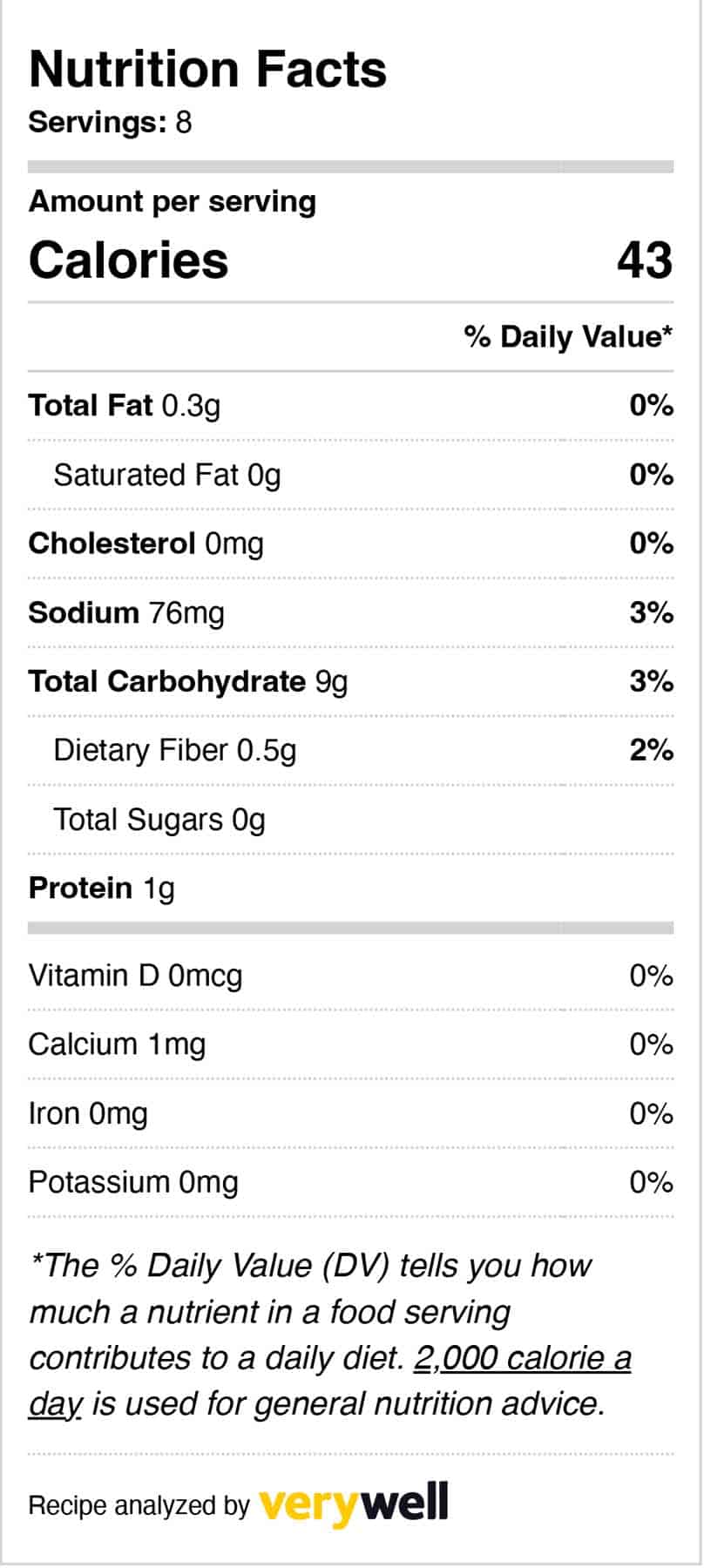


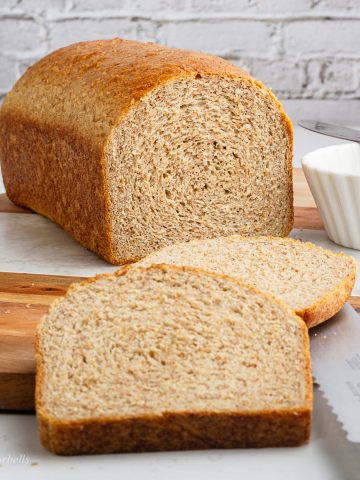
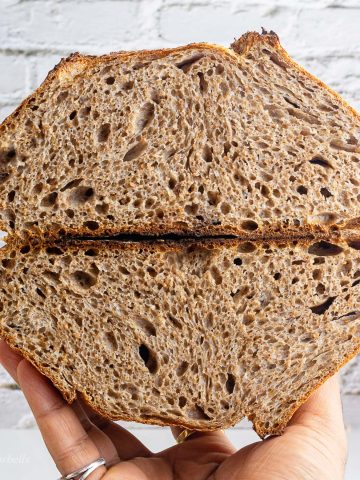


Leave a Reply